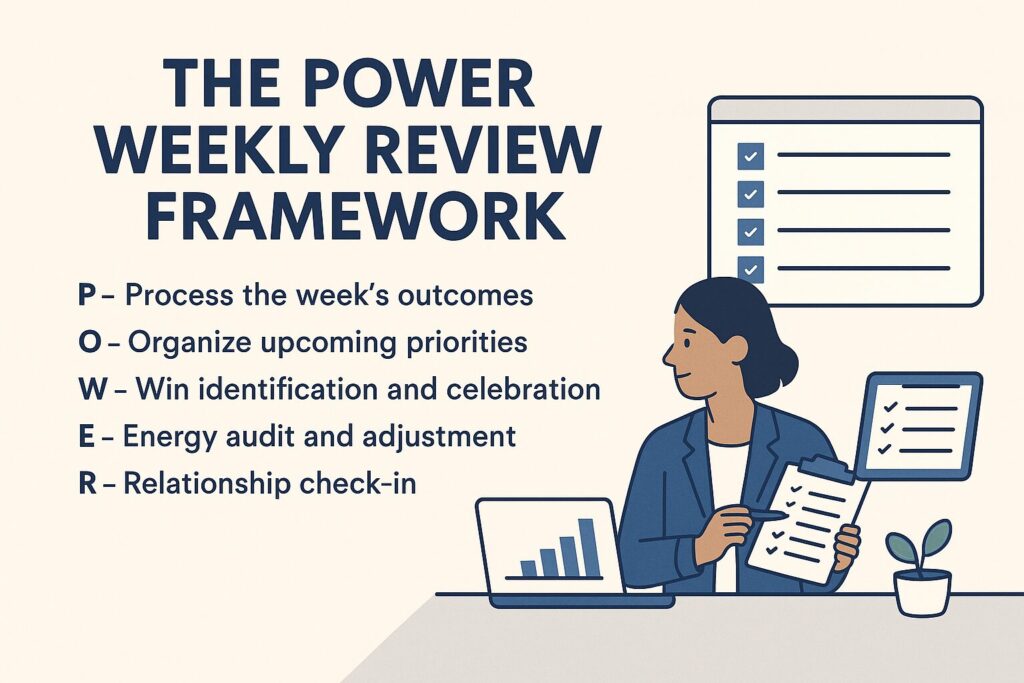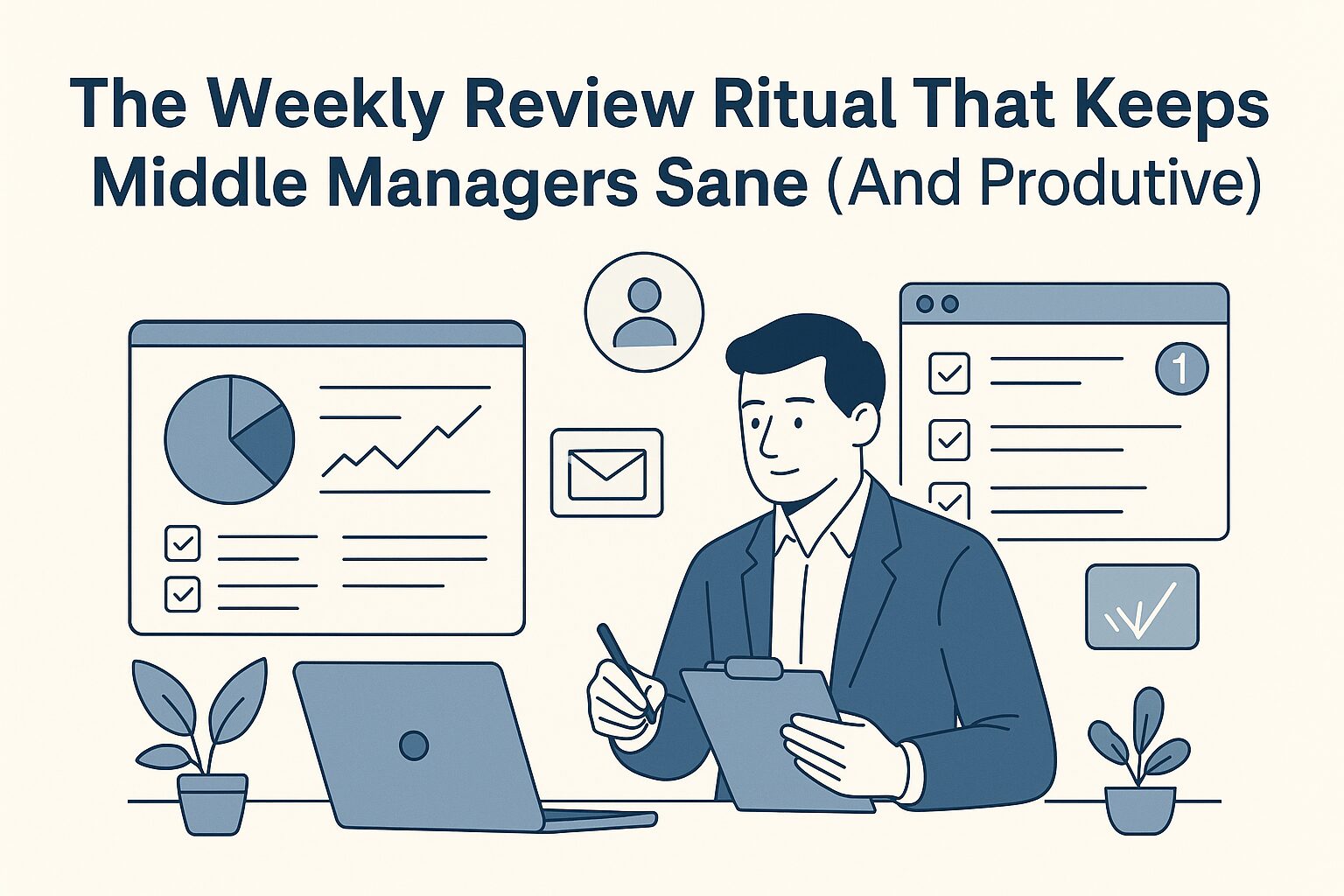Let’s be honest: most weeks feel like survival mode. By Friday afternoon, your inbox is overflowing, half your team is waiting on your feedback, your boss just resurfaced a “quick favor” you forgot about, and those big-picture projects? Still sitting in the parking lot.
That’s where a weekly review ritual becomes your sanctuary, offering a much-needed respite from the chaos and a sense of control over your week.
Instead of drowning in reactive chaos, this simple practice gives you a rhythm to step back, regroup, and reset. It’s the difference between feeling buried by tasks and leading your team with clarity.
Here’s the thing nobody tells you about middle management: you’re running air traffic control for competing priorities while simultaneously trying to be a visionary leader. Research shows that 18% of professionals report being productive less than half of the time, honestly. That tracks with what I see in most organizations.
But here’s what I’ve learned after years of trial and error and more than a few late-night stress spirals: the difference between managers who thrive and those who barely survive isn’t talent, luck, or even caffeine tolerance. It’s having a weekly review ritual that works.
What Most New Managers Get Dead Wrong About “Staying Organized”
Let me tell you about my first spectacular failure as a middle manager. Being organized meant color-coding my calendar and having the perfect task-management app. I spent more time tweaking my productivity system than actually being productive, which was a classic rookie mistake.
I was like that friend who buys all the gym equipment but never works out. I had beautiful project boards, pristine spreadsheets, and enough organizational apps to power a small startup. But when my VP asked me for a quarterly update on our team’s progress, I sat there like a deer in headlights, scrambling through dozens of tools to piece together a coherent story.
The painful truth? I was confusing activity with productivity and tools with systems.
Most new managers make this same mistake. They think staying on top means reacting faster to whatever fires pop up. But that’s not management – that’s professional whack-a-mole. Research from LeadDev indicates that effective managers should review their roles within a specific cadence every 3-6 months to evaluate what they’re trying to achieve and where they spend their time.
The fundamental shift happens when you stop trying to manage everything in real time and start building predictable systems that create space for actual strategic thinking.
The POWER(TM) Weekly Review Framework
After experiencing burnout and witnessing the downfall of many good managers, I crafted the POWER(TM) framework. YES, I love my acronyms. It’s not a revolutionary concept, but it’s intentionally designed to be simple and effective, empowering you to stay on top of your game even in the most chaotic times.
P – Process the week’s outcomes
O – Organize upcoming priorities
W – Win identification and celebration
E – Energy audit and adjustment
R – Relationship check-in

Here’s how it works in practice:
Process (15 minutes)
Every Friday, I do what I call “closing the loops.” I review my weekly task list, calendar, and notes, and sort everything into “3D buckets:” Done, Delayed, or Ditched.
The magic isn’t in the sorting; it’s in asking why things ended in each bucket. Done items show me what’s working. Delayed items reveal bottlenecks or unrealistic expectations. Ditched items (the ones that seemed urgent on Monday but were irrelevant by Friday) teach me about false priorities.
I keep a running tally in a simple spreadsheet. After a few weeks, patterns emerge that are pure gold for improving your effectiveness.
Organize (10 minutes)
Here’s where I get ruthless about next week. Instead of just dumping everything into my calendar, I use the “energy-priority matrix.”
I map tasks by two dimensions: how much mental energy they require and how much impact they’ll have.
High-impact, low-energy tasks get scheduled for when I’m tired. High-impact, high-energy work gets my peak hours. Everything else gets batched or delegated. Research shows that with a weekly time management review, you have an early warning system, which enables you to pick up on the mistake and rectify the situation before too much damage is done.
Win (5 minutes)
This step is a breath of fresh air. I jot down three wins from the week – one personal, one team, and one unexpected. They don’t have to be monumental. Sometimes, it’s as simple as ‘handled that difficult client call’ or ‘finally provided John with the resources he needed.’
Why does this matter? Because middle management is a grind of small victories that nobody notices. If you don’t actively celebrate progress, you’ll burn out from feeling like you’re not making any.
Energy (10 minutes)
I track my energy levels throughout the week and note what drained me versus what energized me. Did three back-to-back Zoom calls leave me useless for the rest of the day? Did that brainstorming session with the product team give me more momentum?
That’s what operational intelligence looks like. Understanding your energy patterns allows you to design your schedule around your natural rhythms instead of constantly fighting them.
Relationship (15 minutes)
Finally, I review my key relationships. Did I give my team the support they needed? Was I responsive to my boss’s priorities? Did I maintain good communication with cross-functional partners?
I keep a simple relationship dashboard – nothing fancy, just a note about whether each key relationship is trending positive, neutral, or needs attention. When someone moves to “needs attention,” that becomes a priority for the following week.
Real-World Example: How This Saved My Product Launch
We were six weeks out from launching a major feature update a couple of years ago. Everything that could go wrong was going wrong – engineering delays, design changes, marketing timeline shifts- classic middle management chaos.
My old approach would have been to work more hours and hope everything synchronized. Instead, I leaned hard into my weekly review ritual.
Week 1’s Process step revealed that 70% of my “urgent” tasks were just status update requests from anxious stakeholders. The real work was getting buried under communication overhead.
In week 2’s Organize phase, I batched all status communications into two weekly update emails instead of responding to individual requests. As a result, I freed up 8 hours that I could spend on problem-solving.
Week 3’s Energy audit showed that engineering sync meetings at 4 PM were killing my productivity. When I fought through the urgent tasks and endless meetings, I had drained my mental energy and couldn’t tackle complex problems. I moved them to 10 AM and suddenly had functional afternoon time again.
By Week 4, the Relationship check-in flagged that our design lead felt disconnected from the broader team. A quick coffee chat revealed she had concerns about the user experience that could have derailed the launch if they’d surfaced later.
The result? We launched a product that worked on time. But more importantly, I didn’t burn out my team or myself. The weekly review ritual kept me focused on what mattered instead of reacting to the loudest voice in the room.
Quick Wins You Can Implement This Week
Ready to try this? Here are the tactical moves that will give you immediate results:
Set a Sacred Time Block
Pick the same time every week for your review and treat it like a client meeting. I do mine on Friday afternoon because it creates natural closure for the week, but find what works for your schedule. The key is consistency; this only works if you do it.
Start with Just 30 Minutes
Don’t try to do a perfect 60-minute review right out of the gate. Start with 30 minutes and focus on just Processing and Organizing. Focus on building the habit first, then layer in the other elements.
Use the “Three Things” Rule
In each section, focus on identifying just three key insights or actions. Three delayed tasks reveal a pattern. Three energy drains to address. Three relationship check-ins to prioritize. More than three, and you’ll get overwhelmed and quit.
Track Your “Weekly Theme”
At the end of each review, write one sentence that captures the theme of your week. “Week of constant interruptions.” “Week of finally getting traction on the Q3 initiative.” “Week of putting out other people’s fires.” These themes become incredibly valuable for pattern recognition over time.
Create a Simple Template
Don’t overcomplicate this. A basic Google Doc with headers for each POWER element is plenty. The goal is reflection and planning, not creating a beautiful document.
The Compound Effect of Consistent Weekly Reviews
Nobody tells you about weekly review rituals: the magic isn’t in any review. It’s the compound effect of doing them consistently over months.
After three months of weekly reviews, you’ll start recognizing patterns in your work that were invisible before. After six months, you’ll intuitively know which meetings are worth your time and which aren’t. After a year, you’ll have developed an operational sixth sense that makes you look like a management wizard to your peers.
The managers who consistently outperform their peers aren’t necessarily more intelligent or talented. They’re just more intentional about learning from their own experience. They treat each week as data, not just time that happened.
In a world where most middle managers are drowning in reactive work, having a weekly review ritual is like having a GPS while everyone else drives around lost. You might not move faster, but you’ll arrive at better destinations.
And honestly? After years of perfecting this system, Friday afternoons have become my favorite part of the work week. There’s something deeply satisfying about closing loops, celebrating wins, and setting yourself up for success. It’s like cleaning your desk, but for your entire professional life.
Your future self will thank you for starting this habit. Trust me on this one.
Ready to implement your weekly review ritual? I’d love to hear how you adapted this framework to your unique situation.
Related Articles
The Modern COO: From Operations to Strategic Growth Architect
Boost Startup Growth with a 3-Layer Ops System
Unlock Better Leadership: Use the Radical Candor Framework Today
Build a Team That Runs Without You – Remarkable Autonomy Now
About the Author
I write about:
- AI + MarTech Automation
- AI Strategy
- COO Ops & Systems
- Growth Strategy (B2B & B2C)
- Infographic
- Leadership & Team Building
- My Case Studies
- Personal Journey
- Revenue Operations (RevOps)
- Sales Strategy
- SEO & Digital Marketing
- Strategic Thinking
📩 Want 1:1 strategic support?
🔗 Connect with me on LinkedIn
📬 Read my playbooks on Substack

Leave a Reply